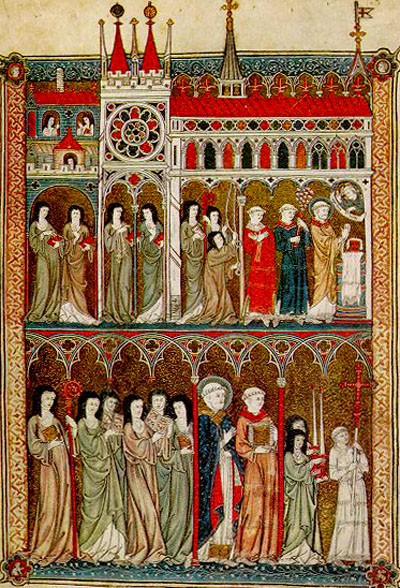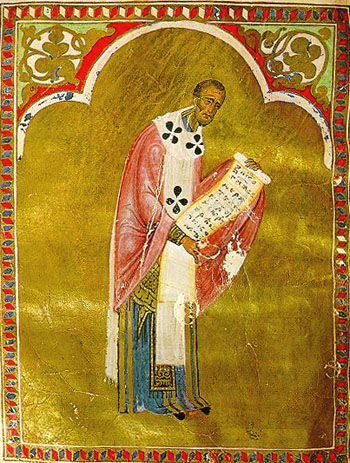 |
Catholic Customs
A Study of the Veil in the Christian Tradition - Part 2
The Veil and the Church Fathers
Donald P. Goodman III
Much of what the Apostles wrote has, alas, been lost in the depths of History; the violent persecution which has accompanied Christianity in all times and all places destroyed forever a great deal of the apostolic works. However, the Apostles trained their successors, who continue to rule the Church even in our present day.

Women with heads covered process in a Church
13th century French manuscript |
The first several generations of these successors, down to the great St. John Damascene, are known as the Fathers of the Church, and the Church esteems their opinion so highly that she teaches that, when all the Fathers are united on a given subject, their word is infallible, and all Catholics are required to believe it for their salvation.
I therefore turn to these eminent and holy men: What did they think of the veil, and in what circumstances did they require Catholics to wear it?
Largely, to the best of my knowledge, they wrote just a few things on the subject. The Fathers were constantly combating the great theological and Christological heresies. Yet even in these circumstances, some found time to speak on the veil. This is a testament both to their tireless zeal for their flocks as well as to the importance they attached to the veil. I shall approach the writings, of several eminent Fathers on the subject and examine their reasoning and their force.
How binding should their opinions be, however, if there is not a universal concurrence among them? This is a difficult question to answer. The modern man’s instinct rejects their arguments as utterly without truth, as the radical ramblings of men known for their extremism. The sensus catholicus, however, demands a more equable approach. While the writings of a single Father, or even of multiple Fathers, are certainly not authoritative, the Church does, and always has, held out the opinions of these men as guides for all men and all ages through this valley of tears. Sometimes, the writings of various Fathers are condemned as the Church further clarifies Catholic doctrine; for example, the teachings of St. Gregory of Nyssa in regard to universal salvation, or Tertullian’s writings defending Montanism.
When the Church has not invalidated the teachings of the Fathers, however, they must be given a certain respect beyond that accorded to our own opinions, or even the opinions of more modern interpreters of Scripture. Their proximity to the Apostles, to whom Our Lord directly imparted His teaching for all the ages, as well as their evident and universally (1) acknowledged holiness, can allow no modern scholar by the force of his own arguments to prevail over their positions. We must, then, respect and acknowledge the conclusions of the Fathers on this matter as a legitimate part of the Catholic tradition, if not necessarily the one correct interpretation, and we can only reject it as incorrect if the Church or the weight of the Doctors’ opinions fall against them.
How, then, can we arrive at the truth in this regard? We will examine the opinions of each Father who has written on this topic and try to find some concurrence, for when the Fathers are universally in accord on any matter, the truth of it can hardly be debated. We will examine such eminent Fathers and theologians as St. John Chrysostom, he of the golden tongue, and the undisputed master of all the Fathers, the summit of the patristic age, St. Augustine, and examine their opinions on I Corinthians 11 and their writings about its significance. In this way we will come to a more thorough understanding of the Christian tradition of the veil, and at least come closer to the truth on the matter, which is relevant for all ages and all men.
3.1 St. John Chrysostom
St. John Chrysostom spoke the most prolifically and the most forcefully of all the Fathers on the subject of the veil. Both in regard to the importance he attached to it and to the stringency of his regulations, St. John was by far the most adamant in insisting on the veil for women. He unequivocally states that “being uncovered is always a reproach” for women, thus taking an even stricter position than our reading of I Corinthians led us to believe the Apostle assumed.
St. John Chrysostom argues that a woman ought to “be carefully wrapped up on every side” at all times, basing his argument directly on the text of St. Paul’s Epistle. For St. John Chrysostom, St. Paul legislated continual wearing of the veil even when not at prayer. Rather than interpreting this verse – “for it is all one as if she were shaven” – as an analogy, he claims that it is an identification of the two states, saying that “if to be shaven is always dishonorable, it is also plain that being uncovered is always a reproach.”

St. John Chrysostom |
St. John Chrysostom argues that St. Paul made his intention even clearer in verse 10, which according to him clearly indicates that St. Paul “signifies that not at the time of prayer only but also continually, she ought to be covered.” Is this interpretation correct?
According to my facial reading of the text, it was clearly not St. Paul’s explicit intention to mandate continual veiling of women. St. Paul was never timid when it came to legislation, and we may safely assume that had he meant that women must be veiled at all times, he would have said so. Instead, he mandated only that they be covered at the time of prayer, referring to the law of nature itself to justify his command. So is St. John Chrysostom really arguing that St. Paul mandated continuous covering, and if so, can his reading be defended?
There is a certain logic to St. John’s argument. Essentially, St. John Chrysostom sets up a syllogism based on the words of the Epistle. The major premise is from verse 6, that “if a woman be not covered, let her be shorn.” The minor premise is from verse 15, that “if a woman nourish her hair, it is a glory to her,” which implies that a woman being shaven is a disgrace. St. John’s syllogism, then, on which he rests his argument, is as follows:
• An uncovered woman is like a shorn woman.
• A shorn woman is disgraced.
• Therefore, an uncovered woman is disgraced.
Now, it seems to me that a disgrace brought deliberately upon oneself is a sin; therefore, a woman being uncovered would be a sin. This reading is certainly justified by the text, and not as radical as might at first appear. Is this the correct interpretation of St. John Chrysostom’s comment? Is his comment decisive on the topic?
He makes another argument in favor of his point by referencing St. Paul’s rhetorical style. St. John Chrysostom claims that St. Paul “by reducing it to an absurdity ... appeals to their shame.” St. Paul is, then, making a reductio ad absurdum argument, a rarely successful type of argument and certainly not compelling in this case, but an argument, and a valid reading of St. Paul’s text. Nevertheless. St. John Chrysostom claims that verse 6 – “if a woman be not covered, let her be shorn” – is “a severe reprimand,” being equivalent to “if thou cast away the covering appointed by the law of God, cast away likewise that appointed by nature.” This reading assumes, of course, the validity and truth of the syllogism given above, but it does make sense of the verse based upon that assumption.
Finally, St. John Chrysostom took an unusual approach to verse 16 of the Veil Text. Modern readers often see this as a sort of escape clause, as if St. Paul were saying that the argument he had just made really isn’t very important, after all, and that it would be better to cast it aside than to insist on it in the face of contention. St. John Chrysostom, on the other hand, takes a different view. He holds that St. Paul is saying this:
“It is then contentiousness to oppose these things, and not any exercise of reason. Notwithstanding, even thus it is a measured sort of rebuke which he adopts to fill them the more with self-reproach; which in truth rendered his saying the more severe. ‘For we,’ saith he, ‘have no such custom,’ so as to contend and to strive and to oppose ourselves. And he stopped not even here, but also added, ‘neither the Churches of God;’ signifying that they resist and oppose themselves to the whole world by not yielding.”
St. John Chrysostom holds that those who oppose the Apostle’s teaching are fighting against the Church, and maintains that “that custom” refers rather to the custom opposing his teaching, rather than the custom that he is teaching. This argument is later made again by St. Thomas Aquinas, and so I will not elaborate further here. Suffice to say that St. John Chrysostom certainly did not hold that verse 16 was a release from obedience to the veil tradition. On the contrary, he considered it a rebuke from St. Paul for failure to adhere to it.
Was St. John Chrysostom’s conclusion supported by the other Fathers, either in his interpretation of the Veil Text or in his legislation regarding the veil? I will analyze the opinion of St. Ambrose, Bishop of Milan, and St. Augustine on the veil in my next installment.
1. Universally, at least, among Catholics. But as the word “catholic” means “universal,” we hold that any opinion universal among Catholics is universal enough to be called so.
2. St. John Chrysostom, Homilies on First Corinthians, Homily XXVI, on this site. Viewed on 22 April 2004.
3. Ibid.
4. I Corinthians 11:5.
5. St. John Chrysostom, Homilies on First Corinthians.
6. “Therefore ought the woman to have a power over her head, because of the angels.”
7. St. John Chrysostom, Homilies on First Corinthians
8 . I Corinthians 11:14.
9. St. John Chrysostom, Homilies on First Corinthians.
10. Ibid.
11. “But if any man seem to be contentious, we have no such custom, nor the church of God.”
12. St. John Chrysostom, Homilies on First Corinthians.

Posted May 7, 2005
Go to Introduction Part 1 Part 3 Part 4 Part 5 Part 6 Conclusion
The pleasure TIA has to publish collaborations of our guest columnists does not imply that it endorses all the opinions expressed in their articles.
Return to TOP

Related Topics of Interest
 Restoration: Let's Begin with the Veil Restoration: Let's Begin with the Veil
 St. Pius X on Priestly Dignity and Propriety St. Pius X on Priestly Dignity and Propriety
 Titles and Signs of Respect for Priests and Religious Titles and Signs of Respect for Priests and Religious

Related Works of Interest
|
Catholic Customs | Religious | Home | Books | CDs | Search | Contact Us |
Donate

© 2002- Tradition in Action, Inc. All Rights Reserved
|
 |
|